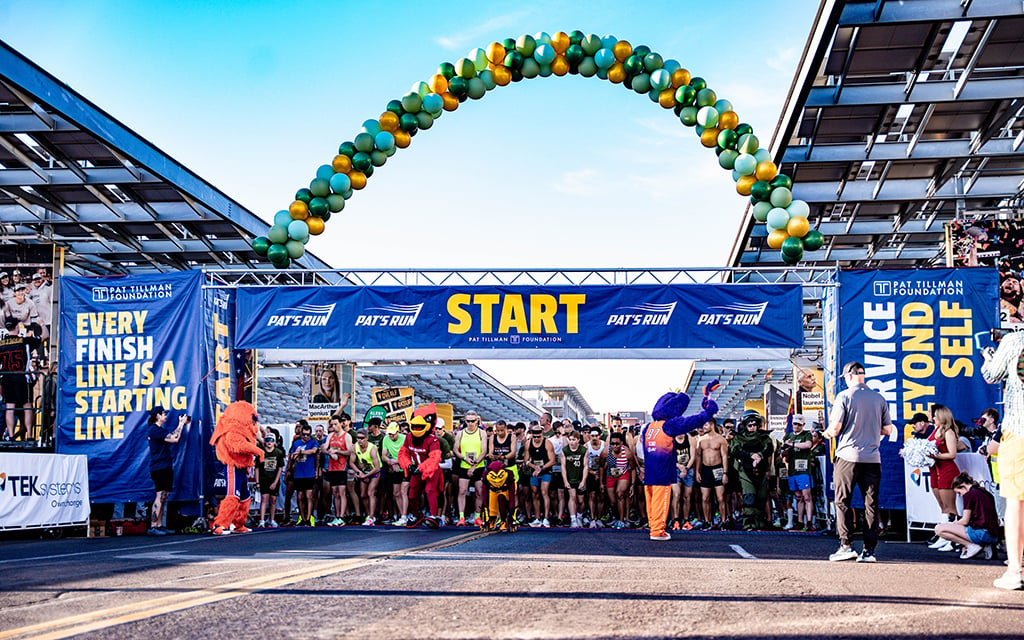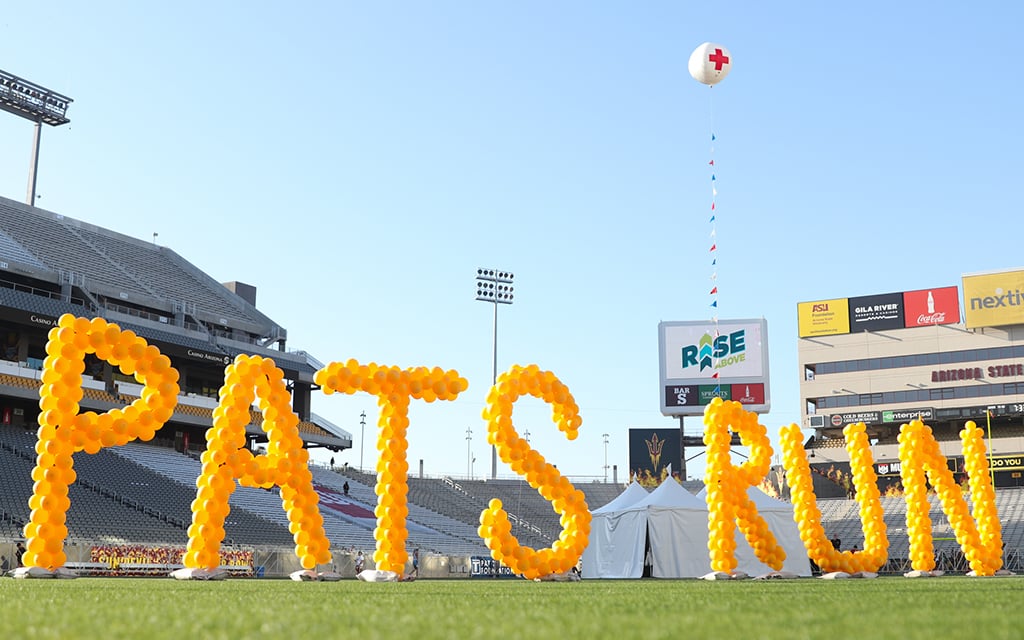TEMPE – As Arizona State football coach Kenny Dillingham blew the airhorn signifying the start of the 21st annual Pat Run, runners began their 4.2-mile journey through Tempe to salute the legacy of Pat Tillman.
They traveled in wheelchairs, full military gear and with flags in their grip. Some sprinted, others walked. And when they finally entered Mountain America Stadium to finish at the 42-yard line, the physical exhaustion was visible, but the emotional joy unmatched.
The first wave of runners included men and women, many of whom had put months of effort into preparing for the race and training to finish with the best result possible. One of those was Madelyn Cowley, who posted a first-place finish in the women’s age group 20-29 and second place overall among women.
It was Cowley’s first time ever winning a road race, and the time put aside while also caring for her family was well worth it.
“All of the moms out there that want to keep at it with their hobbies, with their passions, with running or whatever it may be, moms can do it, too,” Cowley said.
The first hour of the race saw athletes from all walks of life, including Matthew Orsburn, the first adaptive athlete to finish the 4.2-mile course. Orsburn believes no one in the disabled community should doubt what’s possible.
“They can do it, too,” he said. “Just because you’re limited by something doesn’t mean you can’t adapt and overcome. Pat Tillman said somewhere inside us, we hear a voice. It leads us in the direction of the person we wish to become, but it’s up to us whether or not to follow.”
For Orsburn, Tillman’s inspiration and the decision one man made over 23 years ago to leave the glory of the NFL looms large. He believes the challenges faced on the course are his responsibility to overcome, and while the race embraces adaptive athletes, there’s still work to be done to make the course inclusive to all.
“Things such as the rubber mats at the finish line, they catch on your casters and slow you down a lot,” he said. “I’ve spoken to some people, and it’s going to take some more work. Maybe next year we get a walkway for adaptive athletes.”
Many of the participants in the Tillman race were running for a greater cause. Jack Frus, a first lieutenant joined by a few of his fellow soldiers, completed the run wearing a roughly 88-pound EOD 9 Army bomb suit and helmet in the blazing Tempe sun, in honor of the EOD (Explosive Ordnance Disposal) Warrior Foundation that supports EOD techs and their families while they’re here and once they’re gone.
“I’m a big fan of ASU, I’m an ASU ROTC rat, and now I’m a bomb squad member stationed out of Fort Carson, Colorado,” Frus said. “I had to come out here to raise some money, raise awareness, and suffer a bit in the heat.
“The run was pretty rough. I ran about 10 miles in the bomb suit to prep up in Colorado, where it is a lot colder. I forgot just how hot it is out here.”
Also in the race was long-time run participant Thomas Mortensen, a military veteran who has competed in 13 of the 21 years of the event. Mortensen, who was a friend of the recruiter who brought Tillman and his brother Kevin into the military, has seen the race grow exponentially over the years.
“Since its original 2005 run, the race has tripled in size, with up to 30,000 participants. The way it has grown is just amazing.”
As many know, Pat Tillman was drafted by the Arizona Cardinals in 1998. However, he walked away from a multi-million dollar contract in 2002 to join the elite Army Rangers following the 9/11 attacks. Tillman was killed on April 22, 2004, when he was struck by friendly fire during a firefight near Spera, Afghanistan. He is remembered as more than just an Arizona State football legend. He became an icon who symbolizes service above fame and money.
As the years go by, each run signifies the continuation of his legacy, inspiring generations of families with the same pride Pat Tillman showed over a decade ago. It also serves as the primary fundraiser for the Pat Tillman Foundation, which has funded more than 900 “Tillman Scholars,” who include active-duty service members, veterans and military spouses.
Jake Jessup, a runner who completed the run with his wife and had his daughter in attendance for the first time, said the event joins people honoring Tillman’s spirit of service.
“We were able to come together under one aspect, one category, and running for a veteran who risked his life and gave his life to protect us,” Jessup said.
Tillman’s legacy has also inspired people who are dealing with lifelong hurdles, including some like Mark Milow, who is affected by a degenerative neurological disorder.
In the spring of 2020, Milow began suffering from central tremors in his hands, which at first he expected would require nothing more than a doctor’s visit.
“Through the year 2020, my left arm stopped swinging, but I didn’t know that was related,” Milow said. “Watching TV with my brother, I crossed my arms and I was completely locked up. I couldn’t get up.”
Milow called his doctor to schedule a second visit, and in February of 2021, Milow was diagnosed with early-onset Parkinson’s.
Once diagnosed, Milow found his calling and felt that there was more to life than just feeling sorry for himself. Milow signed up for the Pat Run to raise awareness for Parkinson’s, and in his words, “Raising awareness was part of my therapy.”
“Movement is the only thing that’s proven to stop progression of Parkinson’s, so I signed up for as many walks and runs as I could,” Milow said. “Tillman’s run is the most significant, because Phoenix and Pat Tillman’s run are synonymous, Pat Tillman is so revered here as he should be as a college player, pro player, and a hero.”
Beyond the respect for Pat Tillman, family bonds stood out the most this past Saturday in Mountain America Stadium. Many families embraced and cheered as they crossed the finish line.
For Spencer Chavez, a U12 runner, Saturday was a special day. In his slightly oversized Tillman shirt, he was joined by his sister, mother and father as he completed the 4.2-mile run, a family tradition he plans to continue for the rest of his life.
“I always run with my family,” Chavez said. “I’ve been doing this for my whole life with my dad, and today with my sister. I’ve always wanted to catch up to them, and this time I said I really want to run it, so I did.”




